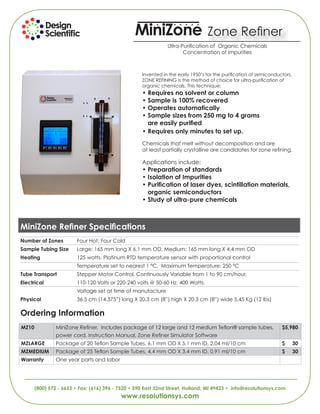
MiniZone_SpecSheet1
- 1. Zone Refiner (800) 572 - 6653 • Fax: (616) 396 - 7520 • 590 East 32nd Street, Holland, MI 49423 • info@resolutionsys.com www.resolutionsys.com Ultra-Purification of Organic Chemicals Concentration of Impurities Invented in the early 1950’s for the purification of semiconductors, ZONE REFINING is the method of choice for ultra-purification of organic chemicals. This technique: • Requires no solvent or column • Sample is 100% recovered • Operates automatically • Sample sizes from 250 mg to 4 grams are easily purified • Requires only minutes to set up. Chemicals that melt without decomposition and are at least partially crystalline are candidates for zone refining. Applications include: • Preparation of standards • Isolation of Impurities • Purification of laser dyes, scintillation materials, organic semiconductors • Study of ultra-pure chemicals MiniZone Refiner Specifications Number of Zones Four Hot; Four Cold Sample Tubing Size Large: 165 mm long X 6.1 mm OD, Medium: 165 mm long X 4.4 mm OD Heating 125 watts. Platinum RTD temperature sensor with proportional control Temperature set to nearest 1 ºC, Maximum Temperature: 250 ºC Tube Transport Stepper Motor Control, Continuously Variable from 1 to 90 cm/hour. Electrical 110-120 Volts or 220-240 volts @ 50-60 Hz, 400 Watts. Voltage set at time of manufacture Physical 36.5 cm (14.375”) long X 20.3 cm (8”) high X 20.3 cm (8”) wide 5.45 Kg (12 lbs) Ordering Information MZ10 MiniZone Refiner. Includes package of 12 large and 12 medium Teflon® sample tubes, power cord, Instruction Manual, Zone Refiner Simulator Software $5,980 MZLARGE Package of 20 Teflon Sample Tubes, 6.1 mm OD X 5.1 mm ID, 2.04 ml/10 cm $ 30 MZMEDIUM Package of 25 Teflon Sample Tubes, 4.4 mm OD X 3.4 mm ID, 0.91 ml/10 cm $ 30 Warranty One year parts and labor
- 2. Zone Refiner Ultra-Purification of Organic Chemicals Concentration of Impurities In Zone Refining, a short molten zone travels slowly through an elongated sample of a crystalline mate- rial. A molten zone traversing a solid sample has two liquid-solid interfaces; a melting interface and a freezing interface. At the melting interface the composition sample of a crystalline material. A molten zone tra- versing a solid sample has two liquid-solid interfaces; a melting interface and a freezing interface. At the melting interface the composition does not change but at the freezing interface, the impurities favor the liquid phase because the crystal structure tends to exclude molecules that do not readily fit into the crystal lattice. Passing the molten zone(s) through the sample many times concentrates the impurities at one end leaving the opposite end highly purified. The photo shows a sample during the refinement process in the MiniZone re- finer. The sample is contained in one (or two) disposable, thin- walled Teflon® sample tubes. These tubes are filled with the sample and clamped on each end in the tube transport mechanism. (The metal blocks at the top and bottom of the photo.) The transport mechanism slowly moves the tubes downward, passing them through the four heating and four cooling zones of the temperature regulated metal blocks. After the tubes move downward the distance of one hot zone and one cold zone (two centimeters), the trans- port mechanism is reversed and the tubes are quickly moved upward to the original position. The net result of this motion is that the molten and crystalline zones migrate slowly and continuously upward with respect to the tubing. With a typical zone rate of 2 cm/hr and with four ac- tive zones, each portion of the sample is subjected to one purifying phase transitions per hour. Usually within 18 hours of automatic operation (18 recrystal- lizations), the sample is purified. After the sample tube is cooled, it is removed from the MiniZone. The refined sample is easily recovered by cutting the tube into sections. The major portion of the impurities are con- centrated at one end of the tube. For more information on zone refining, please visit our web site at www.resolutionsys.com. Free Zone Refiner Simulator Software Explains the theory of zone refining and displays how the sample is purified. E-mail info@resolutionsys.com to request your free copy.